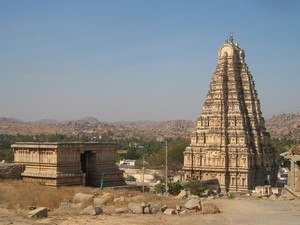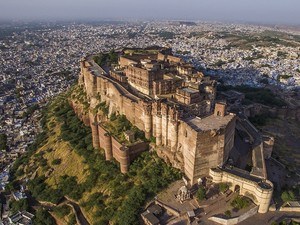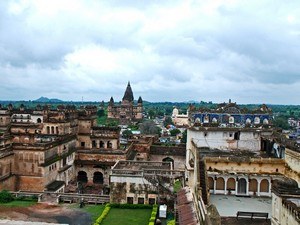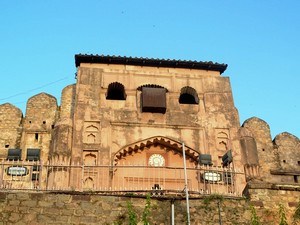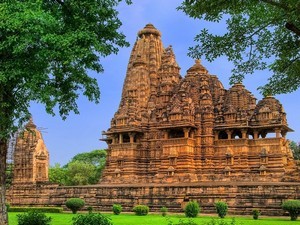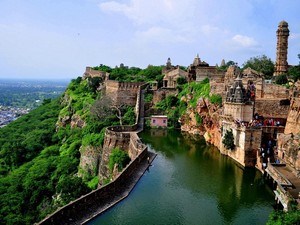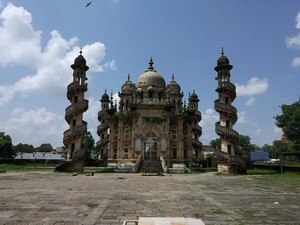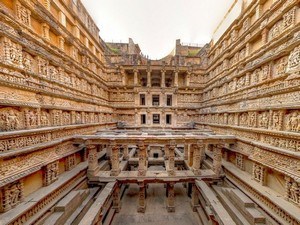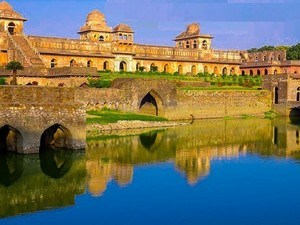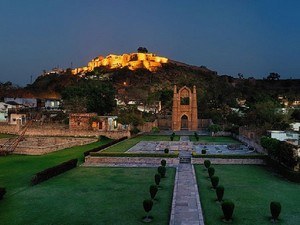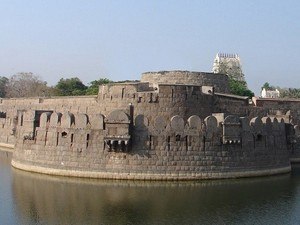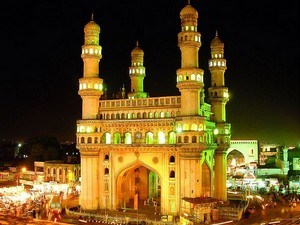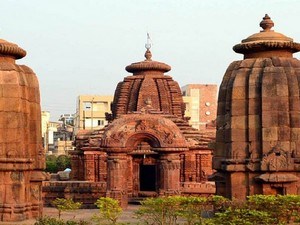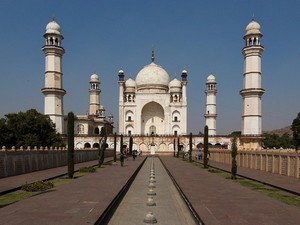1
DAY 1 : TRAVEL TO BIDAR & SIGHTSEEING
DAY 1 : TRAVEL TO BIDAR & SIGHTSEEING
 Sightseeing
Sightseeing
Leisure / No Sightseeing
At a distance of 2.5 km from Bidar Railway Station, Bidar Fort is an ancient fort situated in Bidar, Karnataka. It is one of the magnificent forts in Karnataka and among the prominent tourist places in Bidar.
The initial Bidar Fort is considered to have been built during the reign of the Western Chalukya dynasty which was established in 977 AD at Kalyani. Subsequently, it was captured by the Yadava dynasty of Devagiri and fell yet again to the Kakatiyas of Warangal. Bidar Fort was rebuilt by Sultan Ahmed Shah Wali of the Bahmani dynasty when his capital was moved from Gulbarga to Bidar in 1430 along with several Islamic monuments.
The Bidar Fort is a specimen of the Persian architectural style having 1.21 km in length and 0.80 km in breadth, with a quadrangular layout. Surrounded by three miles long walls and comprising 37 bastions, it is surrounded by a triple moat. It is among the must-visit places .....
 Duration of visit: 2 Hours
Duration of visit: 2 Hours
 Timings: 9 AM - 5 PM
Timings: 9 AM - 5 PM
At a distance of 2 km from Bidar Railway Station, Mahmud Gawan Madarsa is one of the major historical structures and a beautiful structure situated between the Fort and Chaubara Clock Tower.
Mahmud Gawan Madarsa is an old Islamic university built by Khwaza Mahmud Gawan in 1472. Mahmud Gawan was a Persian merchant who arrived in the Bahamani Sultanate at around 1453 AD. Due to his honesty, simplicity and knowledge he impressed the Bahamani Kings. He ultimately reached to the post of prime minister and was much respected among the local population.
Gawan had built a large madarsa at the centre of Bidar with his own money. It functioned like a university, in the same way as other contemporary madarsas of West and Central Asia and Saharan Africa. The architectural style of the madarsa strongly resembles the buildings of Samarkand.
The Madarsa had an imposing three-story building with 100 feet tall minarets in four corners. .....
 Duration of visit: 30 Mins
Duration of visit: 30 Mins
 Timings: 9 AM to 6 PM
Timings: 9 AM to 6 PM
At a distance of 5.5 km from Bidar Railway Station, Bahmani Tombs located at Ashtur are other important historical monuments in Bidar, after the Fort.
The 12 tombs of Bahmani Sultans are located in the same compound. They are huge structures with beautiful arches, niches and lofty domes. Among all the tombs, the tomb of Ahmad Shah Wali is most popular. Ahmad Shah shifted the capital from Gulbrga to Bidar in 1430 and rebuilt the old fort. Ahmed Shah Bahmani was a religious ruler. He was devoted to Khwaja Bande Nawaz of Gulbarga and later to the order of Shah Nimat-Ullah of Kirman. He was also respected the doctrine of Lingayats, a religious order of Deccan established by the philosopher, statesman and social reformer Basavanna.
Ahmad Shah Wali the 9th Bahmani Sultan died in 1436 and his son Alauddin built a majestic tomb for his father. The walls are about twelve feet thick supporting a huge dome on the top. There are three doors .....
 Duration of visit: 1 Hour
Duration of visit: 1 Hour
 Timings: 9 AM to 6 PM
Timings: 9 AM to 6 PM
At a distance of 5 km from Bidar Railway Station, Narasimha Jhira is a wonderful cave temple situated on the outskirts of Bidar town.
The Narasimha Jhira Cave Temple is dedicated to the lion god Narasimha, an incarnation of Lord Vishnu. It is also known as Narasimha Zarna Cave temple or Jharani Narasimha Temple. People throng to this temple because it is believed that the idol at the Narasimha Jhira Cave temple is self manifested and is very powerful.
The Temple is known for its natural beauty and is considered to be very sacred. This ancient temple is excavated in a 300 m tunnel under the Manichoola hill range. Within the cave, a stream of water is said to be flowing continuously since the foundation of the temple. Devotees have to walk waist deep in the water for 300 m for the darshan of Lord Narasimha.
According to mythology, Lord Narasimha first killed Hiranyakashipu and then proceeded to slay the demon Jalasura who .....
 Duration of visit: 1-2 Hours
Duration of visit: 1-2 Hours
 Timings: 7 AM to 6 PM
Timings: 7 AM to 6 PM
At a distance of 3 km from Bidar Railway Station, the Barid Shahi Tombs are historical monuments situated in Deccan Park and Barid Shahi Park near Bidar Bus Station. The Archaeological Survey of India has declared the group of tombs as national monuments. It is one of the must-include places in Bidar Tour Packages.
The Barid Shahis gained control of the territory around Bidar at the beginning of the 15th century. The tombs of Ali Barid and his son Qasim Barid are located in the sprawling gardens of Deccan Park. The 55-acre garden has hundreds of plants spread across. The main entrance has a gateway on the south, decorated with architectural motifs with star-shaped panels and beautiful patterns. The tombs are among the places to visit in Bidar.
Ali Barid Shah was the most prominent among Baridshahi rulers. He was interested in architecture and built .....
 Duration of visit: 1 Hour
Duration of visit: 1 Hour
 Timings: 4 PM to 8 PM. Closed on Monday.
Timings: 4 PM to 8 PM. Closed on Monday.
2
DAY 2 : VISIT JALSANGVI - BASAVAKALYAN
%%Itinerary_Title_Day2%%
 Sightseeing
Sightseeing
At a distance of 45 km from Bidar and 38 km from Basavakalyan, Sri Kamalishwara Temple also known as Kaleshwara Temple is located in historical village of Jalasangvi. The Jalasangvi village was once a major center of activity during the rule of the Chalukyas of Kalyani. The Kamalishwara temple is said to have been built around 1100 AD by king Vikramaditya VI of the Chalukya dynasty.
Built on a star-shaped platform, the temple was constructed in the Besara style, a unique combination of North Indian Nagara and South Indian Chalukya. It is a small rectangular structure. Inside the temple there is a Shiva Linga. The exterior walls of the temple have preserved some outstanding sculptures. The temple is famous for its outstanding Salabhanjika or Madanika sculptures. They are heavily decorated with ornaments and attires. The most prominent sculpture here is a woman writing an epigraph in Kannada.
The sculptures of Jalasangvi shrine are .....
 Duration of visit: 30 Mins
Duration of visit: 30 Mins
 Timings: 8 AM 6 PM
Timings: 8 AM 6 PM
At a distance of 2 km from Humnabad Bus Station and 51 km from Bidar, Sri Manik Prabhu Temple is located on the confluence of two holy rivulets Viraja and Guru Ganga at the village of Maniknagar.
The Manik Prabhu temple is built over a Sanjeevani Samaadhi of a Saint Sri Sadguru Manik Prabhu Maharaj. He was a great saint and is believed to be the fourth incarnation of Lord Dattatreya. He was born in 1817 and attained Samadhi on 1865.
The saint is renowned for his mystic powers through which he removed the pain and sufferings of many devotees who came to seek his blessings. The saint stressed on the importance of following the path of Bhakti. Sri Manik Prabhu Maharaj has severla poetic contributions which are all dedicated to the Lord Brahma. The saint was given the title of Sakalamatacharya as all communities revered and respected him.
The temple is a unique architectural beauty and a major spiritual and religious centre. The temple attracts both Hindu and Muslim devotees. .....
 Duration of visit: 30 Mins
Duration of visit: 30 Mins
 Timings: 6 AM to 9 PM
Timings: 6 AM to 9 PM
At a distance of 2 km from Humnabad Railway Station and 51 km from Bidar, Sri Veerabhadreshwara temple is a famous pilgrimage center situated at Humnabad.
Sri Veerabhadreshwara Temple was built by Raja Ramachandra Jadhav in 1725. Dedicated to Lord Veerabhadra, another form of Lord Shiva, this temple is famous for its moving pillar. The idol in the sanctum is very magnificent. The temple has two tall lamp pillars about 50 feet high.
According to Mythology, Veerabhadra is a super being created by the wrath of Rudra (Shiva), after Sati, consort of Shiva, self-immolated in the Yagna. Veerabhadra is one of the primary deities of Veerashaiva Lingayat, Pancham-acharyas mainly from Karnataka and Tamil Nadu.
An annual seven-day Veerabhadreshwara Jatra is held in January/February. At this time, this ancient temple of Lord Veerabhadreshwara attracts lakhs of tourists.
Timings: 7 AM - 11 AM and 4 PM - 8 PM.
 Duration of visit: 30 Mins
Duration of visit: 30 Mins
 Timings: 7 AM - 11 AM and 4 PM - 8 PM
Timings: 7 AM - 11 AM and 4 PM - 8 PM
At a distance of 1.6 km from Basavakalyan Bus Stand, 78 km from Gulbarga, and 80 km from Bidar, Basavakalyan Fort, earlier known as Kalyani Fort is located in the town of Basavakalyan. It is one of the popular places of heritage in Karnataka, and among the must include places in Bidar Tour Packages.
Basavakalyan Fort is considered to be one of the oldest and most imposing forts in South India. It was built by King Nalaraja in the 10th century. Basavakalyan, earlier known as Kalyani, was the royal capital of the Western Chalukyan Dynasty from 1050 to 1189. The name was changed to Basavakalyan in 1956. It is named after Basaveshwara, a spiritual scholar from the 12th century. During the rule of Chalukyas, Jainism flourished and a large number of Jain images were carved on the walls of the forts by Chalukya kings. It is one of the most popular places to visit in Bidar.
This .....
 Duration of visit: 1-2 Hours
Duration of visit: 1-2 Hours
 Timings: 9 AM to 5 PM
Timings: 9 AM to 5 PM

